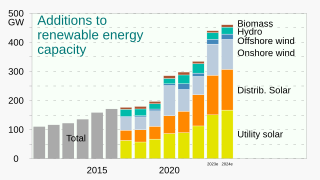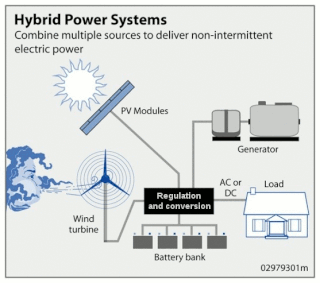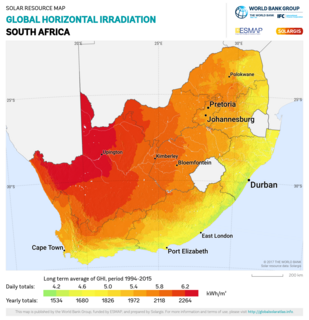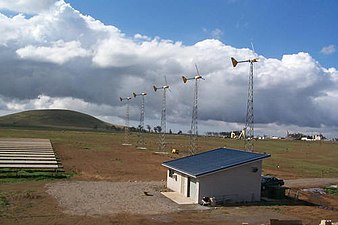
Electricity generation is the process of generating electric power from sources of primary energy. For utilities in the electric power industry, it is the stage prior to its delivery to end users or its storage.

Renewable energy is energy that is collected from renewable resources that are naturally replenished on a human timescale. It includes sources such as sunlight, wind, rain, tides, waves, and geothermal heat. Renewable energy stands in contrast to fossil fuels, which are being used far more quickly than they are being replenished. Although most renewable energy sources are sustainable, some are not. For example, some biomass sources are considered unsustainable at current rates of exploitation.
Distributed generation, also distributed energy, on-site generation (OSG), or district/decentralized energy, is electrical generation and storage performed by a variety of small, grid-connected or distribution system-connected devices referred to as distributed energy resources (DER).

Microgeneration is the small-scale generation of heat and electric power by individuals, small businesses and communities to meet their own needs, as alternatives or supplements to traditional centralized grid-connected power. Although this may be motivated by practical considerations, such as unreliable grid power or long distance from the electrical grid, the term is mainly used currently for environmentally-conscious approaches that aspire to zero or low-carbon footprints or cost reduction. It differs from micropower in that it is principally concerned with fixed power plants rather than for use with mobile devices.

Many countries and territories have installed significant solar power capacity into their electrical grids to supplement or provide an alternative to conventional energy sources. Solar power plants use one of two technologies:

Hybrid power are combinations between different technologies to produce power.

A stand-alone power system, also known as remote area power supply (RAPS), is an off-the-grid electricity system for locations that are not fitted with an electricity distribution system. Typical SAPS include one or more methods of electricity generation, energy storage, and regulation.

Dispatchable generation refers to sources of electricity that can be dispatched on demand at the request of power grid operators, according to market needs. Dispatchable generators can adjust their power output according to an order. Non-dispatchable renewable energy sources such as wind power and solar photovoltaic (PV) power cannot be controlled by operators. Other types of renewable energy that are dispatchable without separate energy storage are hydroelectric, biomass, geothermal and ocean thermal energy conversion.

Spain is one of the first countries to deploy large-scale solar photovoltaics, and as of 2018, is the first country for concentrated solar power (CSP) in the world.

Solar power in India is a fast developing industry as part of the renewable energy in India. The country's solar installed capacity was 47.7 GW as of 31 October 2021.
For solar power, South Asia has the ideal combination of both high solar insolation and a high density of potential customers.

Solar power is the conversion of energy from sunlight into electricity, either directly using photovoltaics (PV), indirectly using concentrated solar power, or a combination. Concentrated solar power systems use lenses or mirrors and solar tracking systems to focus a large area of sunlight into a small beam. Photovoltaic cells convert light into an electric current using the photovoltaic effect.

A photovoltaic system, also PV system or solar power system, is an electric power system designed to supply usable solar power by means of photovoltaics. It consists of an arrangement of several components, including solar panels to absorb and convert sunlight into electricity, a solar inverter to convert the output from direct to alternating current, as well as mounting, cabling, and other electrical accessories to set up a working system. It may also use a solar tracking system to improve the system's overall performance and include an integrated battery solution, as prices for storage devices are expected to decline. Strictly speaking, a solar array only encompasses the ensemble of solar panels, the visible part of the PV system, and does not include all the other hardware, often summarized as balance of system (BOS). As PV systems convert light directly into electricity, they are not to be confused with other solar technologies, such as concentrated solar power or solar thermal, used for heating and cooling.
Renewable energy in Tuvalu is a growing sector of the country's energy supply. Tuvalu has committed to sourcing 100% of its electricity from renewable energy. This is considered possible because of the small size of the population of Tuvalu and its abundant solar energy resources due to its tropical location. It is somewhat complicated because Tuvalu consists of nine inhabited islands. The Tuvalu National Energy Policy (TNEP) was formulated in 2009, and the Energy Strategic Action Plan defines and directs current and future energy developments so that Tuvalu can achieve the ambitious target of 100% renewable energy for power generation by 2020. The program is expected to cost 20 million US dollars and is supported by the e8, a group of 10 electric companies from G8 countries. The Government of Tuvalu worked with the e8 group to develop the Tuvalu Solar Power Project, which is a 40 kW grid-connected solar system that is intended to provide about 5% of Funafuti’s peak demand, and 3% of the Tuvalu Electricity Corporation's annual household consumption.

Different methods of electricity generation can incur significantly different costs, and these costs can occur at significantly different times relative to when the power is used. The costs include the initial capital, and the costs of continuous operation, fuel, and maintenance as well as the costs of de-commissioning and remediating any environmental damage. Calculations of these costs can be made at the point of connection to a load or to the electricity grid, so that they may or may not include the transmission costs.

The energy sector in Hawaii has rapidly adopted solar power due to the high costs of electricity, and good solar resources, and has one of the highest per capita rates of solar power in the United States. Hawaii's imported energy costs, mostly for imported petroleum and coal, are three to four times higher than the mainland, so Hawaii has motivation to become one of the highest users of solar energy. Hawaii was the first state in the United States to reach grid parity for photovoltaics. Its tropical location provides abundant ambient energy.

Solar power in Mexico has the potential to produce vast amounts of energy. 70% of the country has an insolation of greater than 4.5 kWh/m2/day. Using 15% efficient photovoltaics, a square 25 km (16 mi) on each side in the state of Chihuahua or the Sonoran Desert could supply all of Mexico's electricity.

Solar power in South Africa includes photovoltaics (PV) as well as concentrated solar power (CSP). In 2016, South Africa had 1,329 MW of installed solar power capacity. Installed capacity is expected to reach 8,400 MW by 2030.
Solar energy – radiant light and heat from the sun. It has been harnessed by humans since ancient times using a range of ever-evolving technologies. Solar energy technologies include solar heating, solar photovoltaics, solar thermal electricity and solar architecture, which can make considerable contributions to solving some of the most urgent problems that the world now faces.
In 2018 Chile produced about 7% of its electricity from solar power. As of year end, it had 2137 MW of solar PV capacity. In July 2020 installed solar capacity had risen to 3104 MW, with another 2801 MW under construction.


















